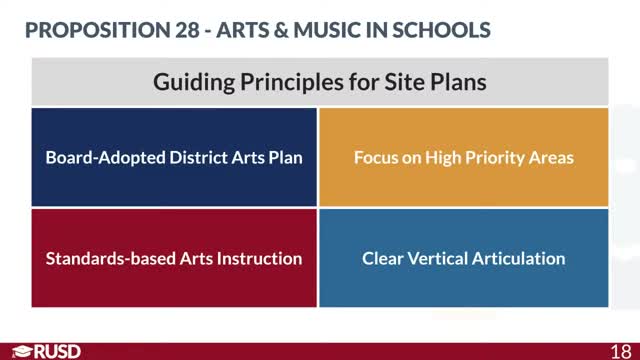Music Education Revolutionizes Early Learning Experience
July 26, 2024 | Riverside Unified, School Districts, California

This article was created by AI summarizing key points discussed. AI makes mistakes, so for full details and context, please refer to the video of the full meeting. Please report any errors so we can fix them. Report an error »

In a recent government meeting, officials discussed the expansion of music education in elementary schools, emphasizing a new initiative that will provide every transitional kindergarten through third-grade student with 30 minutes of music instruction each week. This program, funded by AMS resources, aims to enhance early musical exposure and encourage students to consider learning instruments as they progress through their education.
The initiative is designed to create a seamless transition for students into middle and high school band programs, ensuring that those who wish to continue their musical education have the necessary foundational skills. The discussion highlighted the financial barriers many families face when purchasing instruments, with costs for items like trumpets and violins reaching up to $3,000. By providing instruments through schools, the program seeks to democratize access to music education.
Officials noted that while the 30-minute weekly music class is a significant addition, it is balanced with the need to prioritize core academic subjects, particularly reading. Teachers have expressed the importance of maintaining instructional time, which has led to the decision to limit music instruction to this duration. However, the program is not standalone; it complements existing arts education initiatives, including visual arts lessons, and encourages integration of music across various subjects.
The strategic placement of music programs in elementary schools is also designed to align with high school feeder patterns, ensuring continuity in students' musical education. This approach aims to foster a robust arts education pipeline, ultimately enriching the cultural fabric of the community.
The initiative is designed to create a seamless transition for students into middle and high school band programs, ensuring that those who wish to continue their musical education have the necessary foundational skills. The discussion highlighted the financial barriers many families face when purchasing instruments, with costs for items like trumpets and violins reaching up to $3,000. By providing instruments through schools, the program seeks to democratize access to music education.
Officials noted that while the 30-minute weekly music class is a significant addition, it is balanced with the need to prioritize core academic subjects, particularly reading. Teachers have expressed the importance of maintaining instructional time, which has led to the decision to limit music instruction to this duration. However, the program is not standalone; it complements existing arts education initiatives, including visual arts lessons, and encourages integration of music across various subjects.
The strategic placement of music programs in elementary schools is also designed to align with high school feeder patterns, ensuring continuity in students' musical education. This approach aims to foster a robust arts education pipeline, ultimately enriching the cultural fabric of the community.
View full meeting
This article is based on a recent meeting—watch the full video and explore the complete transcript for deeper insights into the discussion.
View full meeting
